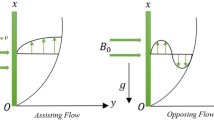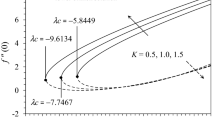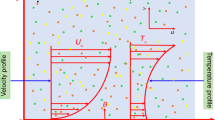Abstract
This investigation is aimed to look at the significance of Joule heating and aligned magnetic effects in porous media saturated by a Ti-alloy/multi-wall carbon nanotube (MWCNT)-water based hybrid nanofluid in the presence of heat generation and velocity slip toward an exponentially shrinking surface. The Tiwari–Das approach is used to develop the mathematical modeling, which is then converted into system of nonlinear ODEs using appropriate similarity transformations. The dual solutions are noticed for the resultant boundary value problem using Newton–Raphson and Runge–Kutta based shooting scheme and then the comparative analysis is provided with existing results. Among these solutions, the first solution is found to be more stable and physically valid over time according to the smallest eigenvalue approach of linear temporal stability analysis. The important outcomes of this study, based on the stable solutions, are: (i) the hybrid nanofluid’s Nusselt number, skin friction, velocity and temperatures rise when the inclined magnetic parameter rises, (ii) the delay of boundary layer separation is noticed with enhancing values of the first-order slip, Darcy porosity and inclined magnetic parameters, (iii) the value of smallest eigenvalue is growing with growing values of the inclined magnetic parameter, and (iv) the thickness of momentum and thermal boundary layers is thinner for the first solution than the second solution. In addition, the delay in boundary layer separation occurs with increasing values of the first-order slip, porosity, and aligned magnetic parameters and decreasing values of the Joule heating parameter. Finally, the streamline patterns are provided in this study to have a better understanding of the fluid flow behavior.
















Similar content being viewed by others
Abbreviations
- \(a_1\) :
-
Velocity slip factor
- b :
-
Velocity parameter of the shrinking surface
- \(b_1\) :
-
Initial length of slip factor
- B(x):
-
Variable magnetic field
- \(B_{0}\) :
-
Strength of the magnetic field
- \(C_\text {f}\) :
-
Skin friction coefficient
- \(C_\text {p}\) :
-
Specific heat capacity with uniform pressure
- f :
-
Dimensionless free stream function
- J :
-
Joule parameter
- k :
-
Thermal conductivity
- \(k^*_\text {p}\) :
-
Permeability of the porous medium
- \(k_\text {f}\) :
-
Thermal conductivity of the base fluid
- \(k_\text {s}\) :
-
Thermal conductivity of the solid nanoparticles
- \(k_\text {hnf}\) :
-
Thermal conductivity of the hybrid nanofluid
- \(k_\text {nf}\) :
-
Thermal conductivity of the nanofluid
- Q :
-
Heat generation parameter
- L :
-
Characteristic length
- M :
-
Magnetic parameter
- \({\text {Nu}}_{\text {x}}\) :
-
Local Nusselt number
- Pd:
-
Darcy porosity parameter
- Pr:
-
Prandtl number
- \(q_{\text {w}}\) :
-
Surface heat flux
- \({\text {Re}}_{\text {x}}\) :
-
Local Reynolds number
- S :
-
Dimensionless suction/injection parameter
- t :
-
Time variable
- T :
-
Fluid temperature
- \(T_\text {o}\) :
-
Temperature parameter of the shrinking surface
- \(T_\text {w}\) :
-
Wall temperature
- \(T_{\infty }\) :
-
Ambient temperature
- (u, v):
-
Velocity components in x and y directions
- \(u_\text {w}(x)\) :
-
Velocity of the shrinking sheet
- \(u_{\infty }(x)\) :
-
Free stream velocity
- \(v_\text {w}(x)\) :
-
Suction or injection velocity
- x, y :
-
Coordinates along and normal to the surface
- \(\eta\) :
-
Dimensionless similarity variable
- \(\epsilon\) :
-
Porosity
- \(\alpha\) :
-
First-order slip parameter
- \(\gamma\) :
-
Incline angle
- \(\lambda\) :
-
Shrinking parameter
- \(\mu _\text {f}\) :
-
Dynamic viscosity of the base fluid
- \(\mu _\text {hnf}\) :
-
Dynamic viscosity of the hybrid nanofluid
- \(\mu _\text {nf}\) :
-
Dynamic viscosity of the nanofluid
- \(\nu _\text {f}\) :
-
Kinematic viscosity of the base fluid
- \(\psi\) :
-
Stream function
- \(\phi _{\text {M}}\) :
-
MWCNT nanoparticle’s volume fraction
- \(\phi _{\text {T}}\) :
-
Ti-alloy nanoparticle’s volume fraction
- \(\rho\) :
-
Density
- \(\rho _\text {f}\) :
-
Density for the base fluid
- \(\rho _\text {hnf}\) :
-
Density of the hybrid nanofluid
- \(\rho _\text {nf}\) :
-
Density of the nanofluid
- \(\rho _{\text{s}}\) :
-
Density of the solid nanoparticles
- \((\rho C_\text {p})\) :
-
Heat capacity
- \((\rho C_\text {p})_\text {f}\) :
-
Heat capacity of the base fluid
- \((\rho C_\text {p})_\text {hnf}\) :
-
Heat capacity of the hybrid nanofluid
- \((\rho C_\text {p})_\text {nf}\) :
-
Heat capacity of the nanofluid
- \((\rho C_\text {p})_\text {s}\) :
-
Heat capacity of the solid nanoparticles
- \(\sigma _{1}\) :
-
Unknown eigenvalue
- \(\sigma _\text {f}\) :
-
Electric conductivity of the base fluid
- \(\sigma _\text {hnf}\) :
-
Electric conductivity of the hybrid nanofluid
- \(\sigma _\text {nf}\) :
-
Electric conductivity of the nanofluid
- \(\sigma _{\text{s}}\) :
-
Electric conductivity of the solid nanoparticles
- \(\tau\) :
-
Time variable
- \(\tau _{\text {w}}\) :
-
Wall shear stress
- \(\theta\) :
-
Dimensionless temperature
- w:
-
Wall condition
- \(\infty\) :
-
Ambient condition
References
Crane LJ. Flow past a stretching plate. Z Angew Math Phys. 1970;21(4):645–7.
Gupta PS, Gupta AS. Heat and mass transfer on a stretching sheet with suction or blowing. Can J Chem Eng. 1977;55(6):744–6.
Wang CY. Liquid film on an unsteady stretching surface. Q Appl Math. 1990;48(4):601–10.
Bhattacharyya K. Steady boundary layer flow and reactive mass transfer past an exponentially stretching surface in an exponentially moving free stream. J Egypt Math Soc. 2012;20(3):223–8.
Magyari E, Keller B. Heat and mass transfer in the boundary layers on an exponentially stretching continuous surface. J Phys D Appl Phys. 1999;32(5):577.
Elbashbeshy EMA. Heat transfer over an exponentially stretching continuous surface with suction. Arch Mech. 2001;53(6):643–51.
Liu IC, Wang HH, Peng YF. Flow and heat transfer for three-dimensional flow over an exponentially stretching surface. Chem Eng Commun. 2012;200(2):253–68.
Ghosh S, Mukhopadhyay S. Stability analysis for model-based study of nanofluid flow over an exponentially shrinking permeable sheet in presence of slip. Neural Comput Appl. 2020;32(11):7201–11.
Miklavčič M, Wang C. Viscous flow due to a shrinking sheet. Q Appl Math. 2006;64(2):283–90.
Merkin JH. On dual solutions occurring in mixed convection in a porous medium. J Eng Math. 1986;20(2):171–9.
Harris SD, Ingham DB, Pop I. Mixed convection boundary-layer flow near the stagnation point on a vertical surface in a porous medium: Brinkman model with slip. Transp Porous Med. 2009;77(2):267–85.
Kameswaran PK, Sibanda P, RamReddy C, Murthy PV. Dual solutions of stagnation-point flow of a nanofluid over a stretching surface. Bound Value Probl. 2013;188(1):1–2.
RamReddy C, Muralikrishna P. Effects of first and second order velocity slips on melting stretching surface in a thermally stratified nanofluid: Tiwari and Das’ model. J Nanofluids. 2017;6(1):155–63.
Chamkha AJ. Solar radiation assisted natural convection in uniform porous medium supported by a vertical flat plate. J Heat Transf. 1997;119(1):89–96.
Pop I, Ingham DB. Convective Heat Transfer: Mathematical and Computational Modelling of Viscous Fluids and Porous Media, Elsevier Science Ltd, Kidlington, Oxford OX5 1GB, UK. 2001.
Nield DA, Bejan A. Convection in Porous Media. New York: Springer International Publishing; 2017.
Choi SU, Eastman JA. Enhancing thermal conductivity of fluids with nanoparticles (No. ANL/MSD/CP-84938; CONF-951135-29). Argonne National Lab., IL (United States). 1995.
Khodadadi H, Aghakhani S, Majd H, Kalbasi R, Wongwises S, Afrand M. A comprehensive review on rheological behavior of mono and hybrid nanofluid: effective parameters and predictive correlations. Int J Heat Mass Transf. 2018;127:997–1012.
Esfe MH, Afrand M. An updated review on the nanofluid characteristics. J Thermal Anal Calorim. 2019;138(6):4091–101.
Okonkwo EC, Wole-Osho I, Almanassra IW, Abdullatif YM, Al-Ansari T. An updated review of nanofluid in various heat transfer devices. J Thermal Anal Calorim. 2021;145(6):2817–72.
Acharya N, Das K, Kundu PK. Effects of aggregation kinetics on nanoscale colloidal solution inside a rotating channel. J Thermal Anal Calorim. 2019;138(1):461–77.
Acharya N. On the flow patterns and thermal behaviour of hybrid nanofluid flow inside a microchannel in presence of radiative solar energy. J Thermal Anal Calorim. 2020;141(4):1425–42.
Acharya N, Mabood F. On the hydrothermal features of radiative Fe3O4-graphene hybrid nanofluid flow over a slippery bended surface with heat source/sink. J Thermal Anal Calorim. 2021;143(2):1273–89.
Ayub R, Ahmad S, Ahmad S, Akhtar Y, Alam MM, Mahmoud O. Numerical Assessment of Dipole Interaction with the Single-Phase Nanofluid Flow in an Enclosure: A Pseudo-Transient Approach. Materials. 2022;15(8):2761.
Ahmad S, Akhter S, Shahid MI, Ali K, Akhtar M, Ashraf M. Novel thermal aspects of hybrid nanofluid flow comprising of manganese zinc ferrite MnZnFe2O4, nickel zinc ferrite NiZnFe2O4 and motile microorganisms. Ain Shams Eng J. 2022;13(5):101668.
Acharya N, Mabood F, Badruddin IA. Thermal performance of unsteady mixed convective Ag/MgO nanohybrid flow near the stagnation point domain of a spinning sphere. Int Commun Heat Mass Transf. 2022;134:106019.
Suresh S, Venkitaraj KP, Selvakumar P, Chandrasekar M. Synthesis of Al\(_2\)O\(_3\)-Cu/water hybrid nanofluid using two step method and its thermo physical properties. Colloids Surf A Physicochem Eng Asp. 2011;388(1–3):41–8.
Leong KY, Ahmad KK, Ong HC, Ghazali MJ, Baharum A. Synthesis and thermal conductivity characteristic of hybrid nanofluid-a review. Renew Sustain Energy Rev. 2017;75:868–78.
Rostami MN, Dinarvand S, Pop I. Dual solutions for mixed convective stagnation-point flow of an aqueous silica-alumina hybrid nanofluid. Chin J Phys. 2018;56(5):2465–78.
Waini I, Ishak A, Pop I. Unsteady flow and heat transfer past a stretching/shrinking sheet in a hybrid nanofluid. Int J Heat Mass Transf. 2019;136:288–97.
Sreedevi P, Sudarsana Reddy P, Chamkha A. Heat and mass transfer analysis of unsteady hybrid nanofluid flow over a stretching sheet with thermal radiation. SN Appl Sci. 2020;2(7):1–5.
Peters M, Kumpfert J, Ward CH, Leyens C. Titanium alloys for aerospace applications. Adv Eng Mater. 2003;5(6):419–27.
Singh P, Pungotra H, Kalsi NS. On the characteristics of titanium alloys for the aircraft applications. Mater Today. 2017;4(8):8971–82.
Iijima S. Helical microtubules of graphitic carbon. Nature. 1991;354(6348):56–8.
RamReddy C, Srivastav A. Aqueous Titanium alloy-MWCNTs hybrid nanofluid flow in a non-Darcy porous medium. Comput Therm Sci. 2021;13(5):31–43.
RamReddy C, Srivastav A. Numerical study and error estimation in power-law nanofluid flow over vertical frustum of a cone. Indian J Phys. 2022;96:1167–79.
Vajravelu K, Rollins D. Heat transfer in an electrically conducting fluid over a stretching surface. Int J Non Linear Mech. 1992;27(2):265–77.
Raju CSK, Sandeep N, Sugunamma V. Unsteady magneto-nanofluid flow caused by a rotating cone with temperature dependent viscosity: a surgical implant application. J Mol Liq. 2016;222:1183–91.
Mortuja Sarkar G, Sahoo B. Dual solutions of a magnetohydrodynamic stagnation point flow of a non-Newtonian fluid over a shrinking sheet and a linear temporal stability analysis. Proc Inst Mech Eng E: J Process Mech Eng. 2021;235(2):527–35.
Anuar NS, Bachok N, Arifin NM, Rosali H. MHD flow past a nonlinear stretching/shrinking sheet in carbon nanotubes: stability analysis. Chin J Phys. 2020;65:436–46.
Waini I, Ishak A, Pop I. Hybrid nanofluid flow induced by an exponentially shrinking sheet. Chin J Phys. 2020;68:468–82.
Takhar HS, Chamkha AJ, Nath G. Unsteady flow and heat transfer on a semi-infinite flat plate with an aligned magnetic field. Int J Eng Sci. 1999;37(13):1723–36.
Srinivasulu T, Goud BS. Effect of inclined magnetic field on flow, heat and mass transfer of Williamson nanofluid over a stretching sheet. Case Stud Therm Eng. 2021;23:100819.
Mahato R, Das M, Nandkeolyar R, Mahala BK. Inclined magnetic field and nonlinear thermal radiation effects on nanofluids flow with homogeneous-heterogeneous reactions. In: AIP Conference Proceedings. AIP Publishing LLC; 2022. Vol. 2435(1), p. 020009.
Swain K, Animasaun IL, Ibrahim SM. Influence of exponential space-based heat source and Joule heating on nanofluid flow over an elongating/shrinking sheet with an inclined magnetic field. Int J Ambient Energy. 2022;43(1):4045–57.
VeeraKrishna M, Subba Reddy G, Chamkha AJ. Hall effects on unsteady MHD oscillatory free convective flow of second grade fluid through porous medium between two vertical plates. Phys Fluids. 2018;30(2):023106.
Krishna MV, Chamkha AJ. Hall and ion slip effects on MHD rotating flow of elastico-viscous fluid through porous medium. Int Commun Heat Mass Transf. 2020;113:104494.
Chamkha AJ. MHD-free convection from a vertical plate embedded in a thermally stratified porous medium with Hall effects. Appl Math Model. 1997;21(10):603–9.
Takhar HS, Chamkha AJ, Nath G. MHD flow over a moving plate in a rotating fluid with magnetic field, Hall currents and free stream velocity. Int J Eng Sci. 2002;40(13):1511–27.
Chamkha AJ. Non-Darcy fully developed mixed convection in a porous medium channel with heat generation/absorption and hydromagnetic effects. Numer Heat Transf A. 1997;32(6):653–75.
Chamkha AJ. Non-Darcy hydromagnetic free convection from a cone and a wedge in porous media. Int Commun Heat Mass Transf. 1996;23(6):875–87.
Chamkha AJ, Ben-Nakhi A. MHD mixed convection-radiation interaction along a permeable surface immersed in a porous medium in the presence of Soret and Dufour’s effects. Heat Mass Transf. 2008;44(7):845–56.
Roberts P. Convection in horizontal layers with internal heat generation. Theory J Fluid Mech. 1967;30(1):33–49.
Hardee HC, Nilson RH. Natural convection in porous media with heat generation. Nucl Sci Eng. 1977;63(2):119–32.
Chamkha AJ. Hydromagnetic three-dimensional free convection on a vertical stretching surface with heat generation or absorption. Int J Heat Fluid Flow. 1999;20(1):84–92.
Chamkha AJ, Al-Mudhaf AF, Pop I. Effect of heat generation or absorption on thermophoretic free convection boundary layer from a vertical flat plate embedded in a porous medium. Int Commun Heat Mass Transf. 2006;33(9):1096–102.
Jafar AB, Shafie S, Ullah I. MHD radiative nanofluid flow induced by a nonlinear stretching sheet in a porous medium. Heliyon. 2020;6(6):e04201.
Sedki AM, Abo-Dahab SM, Bouslimi J, Mahmoud KH. Thermal radiation effect on unsteady mixed convection boundary layer flow and heat transfer of nanofluid over permeable stretching surface through porous medium in the presence of heat generation. Sci Prog. 2021;104(3):1–19.
Ismail NS, Ariffin NM, Nazar R, Bachok N. Stability analysis of stagnation-point flow and heat transfer over an exponentially shrinking sheet with heat generation. Malays J Math Sci. 2019;13(2):107–22.
Yan L, Dero S, Khan I, Mari IA, Baleanu D, Nisar KS, Sherif ESM, Abdo HS. Dual solutions and stability analysis of magnetized hybrid nanofluid with Joule heating and multiple slip conditions. Process. 2020;8(3):332.
Ramreddy C, Saran HL. Dual solutions and their stability analysis for inclined magnetohydrodynamics and Joule effects in Ti-alloy nanofluid: Flow separation. Proc Inst Mech Eng E: J Process Mech Eng. 2022;236(6):2558–69.
Brinkman HC. The viscosity of concentrated suspensions and solutions. J Chem Phys. 1952;20(4):571–571.
Author information
Authors and Affiliations
Corresponding author
Additional information
Publisher's Note
Springer Nature remains neutral with regard to jurisdictional claims in published maps and institutional affiliations.
Rights and permissions
Springer Nature or its licensor (e.g. a society or other partner) holds exclusive rights to this article under a publishing agreement with the author(s) or other rightsholder(s); author self-archiving of the accepted manuscript version of this article is solely governed by the terms of such publishing agreement and applicable law.
About this article
Cite this article
Saran, H.L., RamReddy, C. Analysis of aligned magnetic field, flow separation and stability in a porous medium saturated by hybrid nanofluids. J Therm Anal Calorim 148, 3765–3781 (2023). https://doi.org/10.1007/s10973-023-11946-3
Received:
Accepted:
Published:
Issue Date:
DOI: https://doi.org/10.1007/s10973-023-11946-3




